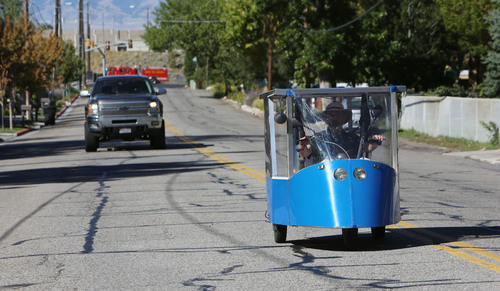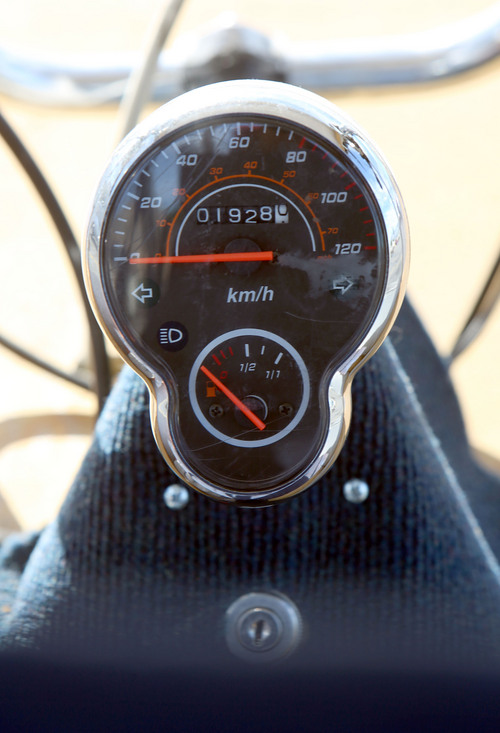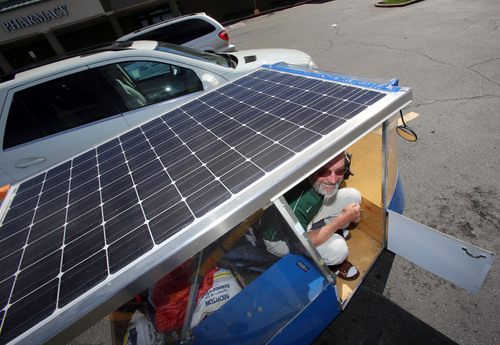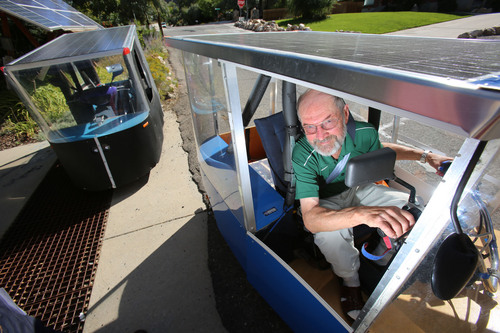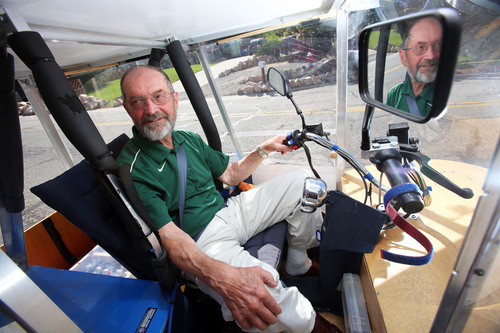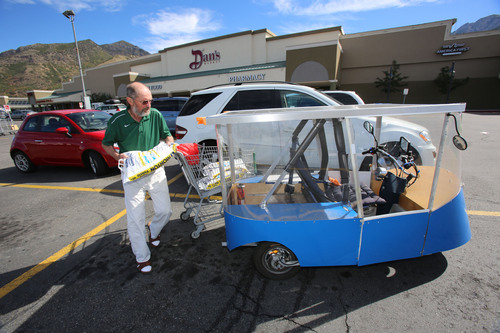This is an archived article that was published on sltrib.com in 2013, and information in the article may be outdated. It is provided only for personal research purposes and may not be reprinted.
Andy Schoenberg was a NASA engineer on projects to provide power for astronauts on the moon. Later, he was a bioengineer for the artificial heart program at the University of Utah. Now, he has developed solar-powered cars that use no-cost fuel and emit no emissions.
He has sometimes even used those cars — with solar panels on their roofs — to help provide electricity for his home after their own batteries were fully charged.
"I think this could solve our air pollution problems along the Wasatch Front," he says with a smile, after driving one of his "ecotrikes" at about 30 mph down the street near his home at the mouth of Millcreek Canyon. "It's fun to drive, too. I can accelerate from a stop about as fast as any other car."
Schoenberg has been working on vehicles with solar-powered fuel stations on their roofs for about 15 years and figures he's finally close to a model that could be mass produced and cost around $6,000.
It now has a range of about 50 miles on level terrain at 30 mph, or 40 miles on hilly terrain. It carries only the driver, but has plenty of room for groceries or other cargo. It is enclosed, so he can use it during winter, yet the three-wheel vehicle is licensed in Utah as a motorcycle with a horn, lights, signals, padded seat and seat belt.
"It's perfect for short commutes and going to the store," he says.
—
University ties • He's working with students at a University of Utah sustainable energy lab to improve the design, increase top speeds — hopefully to about 45 mph — and reduce its production costs even more.
Actually, his commute as a university bioengineering professor — before he retired — spurred him to start working on the project. "The parking was awful. It was impossible to find a parking space," so he started working on a vehicle that could squeeze into spots that others could not use.
His ecotrike does that. It takes less than half of a normal parking space when sitting on all its three wheels. But the 390-pound vehicle is designed so that it easily can be tipped on its end and use even less space — and better aim its roof-top solar panels toward the sun to help recharge.
He lives near Skyline High School and contemplates what popular use of such a vehicle could mean there. "The students at Skyline all drive SUVs and cars to school, and they need acres for parking. They would need only a fraction of that if they drove these."
But his work evolved from trying to solve parking problems to trying to tackle air pollution and energy woes.
Some early versions allowed the driver to pedal to supplement solar power. "It was good exercise, but I found it didn't generate all that much power," Schoenberg says. He started out using technology that was more similar to bicycles, but eventually moved to technology that is more like electric scooters.
—
Power • The current model has a 5-horsepower motor in each of the rear wheels powered by 15 lithium batteries. If the batteries were totally drained, Schoenberg says the rooftop solar panels would require five days to totally recharge them — but they can also be recharged more quickly by plugging into any standard electrical outlet.
"It's possible to commute with 5 to 6 horsepower. You do not need 300 to 400 horses. Statistically, most commutes and going to the store are single-rider trips, so we don't need 4,000-pound cars to get around," he says.
Schoenberg says the solar panels provide enough power to provide about 10 miles of travel a day for free, and plugging in to recharge can increase the range up to 50 miles a day.
The Environmental Protection Agency gives electric cars a mileage per gasoline gallon equivalent rating based on how far they can travel on 34 kilowatts, because that is how much electrical power a gallon of gasoline can generate.
His ecotrike gets 340-350 miles per gasoline gallon equivalent, he says, while bigger multi-passenger, non-solar electric cars on the market get more in the range of 100 miles per gallon equivalent.
Schoenberg figures he spent about $5,500 on materials for the car, and insurance costs him $125 a year. With everything, he figures "it costs about a penny per mile." He says AAA figures most drivers spend 50 cents a mile in traditional cars.
Schoenberg has formed a company called Sunzeecar, has created a video showing his vehicles, and is looking for investors to help him produce them — or sell them as kits. Meanwhile, he says, "This has been a project that has just been a lot of fun to spend time on" during retirement.
People often stop him to ask about the ecotrikes as he drives around — or as people see them parked in front of his home as they head up nearby Millcreek Canyon.
"When they find out it's solar powered, they think it's really cool, especially the young kids. I go to schools to demonstrate the vehicle and talk about energy," he says. "We need things like this to solve our energy and pollution problems."


